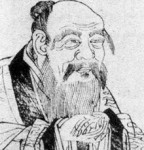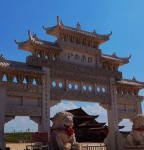漢末蔡邕說:「書有二說,一曰疾,一曰澀,得疾澀二法,書妙矣」
Chinese calligraphy has a special theory and a concept called “Gee & Se ( 疾 澀 ).” "Gee" means fast while "Se" means not slippery, and somewhat slow. These two words are to be understood in metaphysical and artistic perspectives rather than in literal meanings. Gee and Se are the two sides of a coin. They can only be obtained by understanding and applying the Center Tip Principle ( 中 鋒 ). This is why ancient Chinese calligraphers always overstressed the importance of the Center Tip Theory.
In contrast, Western and Japanese calligraphy mostly don’t have the “Gee & Se” effects (except very few Japanese master calligraphers). Japanese calligraphy usually looks more fast and somewhat slippery which is the opposite of “Se.”
Nowadays many Chinese calligraphers don’t understand the concept of “Gee & Se” at all. Some may have never heard of it or may misunderstand and twist it. Some Chinese calligraphers may also interpret this metaphysical concept differently from each other. And some of them try to blend Western and Japanese approaches into Chinese calligraphy. The artistic levels of blended approaches may vary depending on the individual artist’s level and insight.
With the Center Tip Principle, a highly regarded Chinese calligraphy work will generate the following effects:
§ 3.1 - Awl Drawing on Sand “Zuei Hwa Sa” ( 錐 劃 沙 )
We all know writing on paper is a two-dimensional activity while sculpting is three-dimensional. However, this is not so for a Chinese calligrapher who has reached a level that can exemplify “Gee & Se.” If a calligraphy work has attained the effect of Awl Drawing on Sand, it looks like at least three-dimensional. When an awl is used to draw on sand, the sand renders two waves alongside each stroke. If the awl goes in deeply enough, the waves will be higher and more magnificent. Since the sand is never slippery, it has frictions when an awl is traveling on it. The more friction it has, the less likely the work will look plain, superficial, or just two-dimensional.
Taking Yen Jen-Ching’s ( 顏 真 卿 ) famous work for example, when we observe the top three characters in the left column, they have different shades of ink density. They look as if the second character is flowing on top of the first one on a different level of plane; the third character also looks like flowing on top of the second character, and so on. When we take a closer look of the entire work, we may find some characters flowing on other levels of dimension compared with their preceding characters. This makes a Chinese calligraphy work looks like a multi-dimensional display (only if the viewer knows how to appreciate!)
§ 3.2 - Pressing Seal “Inn Inn Nee” ( 印 印 泥 )
A Chinese calligraphy work using the Center Tip technique will also have the effect of “Pressing A Seal.” When a seal is pressed onto a piece of paper, it usually looks more solid, firm, and deeper than an ordinary writing and is "unmovable" and "undetachable." With the vertical force going through the paper from the brush tip, such effect can only be exemplified using the Center Tip Principle.
If a work is not done with enough Center Tip technique, most of the strokes in a character will look weak as if they are detachable. They will look like a building without strong foundation and framework as if its structures can be easily detached or knocked down. (This is also a way to tell good Chinese calligraphy works from bad ones for anyone who has not even learned Chinese calligraphy at all.)
§ 3.3 - Cracking House Effect “Wu Lo Heng” (屋漏痕)
顏真卿的"屋漏痕"本指天雨屋漏,雨水從漏處滲出,沿著牆壁表面蜿蜒流下。由于水
性向下,故水珠重心必居中央,而牆面由于凹凸不平,所以屋漏下滴非一瀉直下,牆
面凸起部分漏水所受阻力小,其流自暢,其勢則疾,而其跡乃真,凹下部分則反之,所以
屋漏之水,雖自上而下,大致垂直,但細處自必蜿蜒曲折,節節頓挫。
Another effect generated by the Center Tip Principle is the Cracking Wall (or House) Effect. Say we want to hang a picture on the wall so we put a nail into the wall. If the hammer and nail are not strong enough, we just make a hole for the picture. But if the hammer VERTICALLY strikes the nail in with MORE POWER, the wall may crack. Furthermore, if we use a powerful drill to make a hole, the wall cracks more and the house may be even knocked down. This is why a master calligrapher’s work usually gives the viewers an overwhelming impression if s/he knows how to apply the vertical force. This effect can be made clear with the Center Tip Principle because a brush is required to stay vertical and the brush tip should be centered during each stroke's operation almost all the time.
In the Tang Dynasty when Chinese calligraphy reached its peak, calligraphers deeply stressed the criterion of “Wu Lo Heng” for good works. Yen Jen-Ching used to explain this concept to the famous Tsao Shu specialist Huai Su. So they both inherited those secrets from Zhang Shui and the other predecessors. Huai Su also pointed out the cracking effect should look natural, not man-made or mechanical. (Please understand when we write, we don’t want to tear or crack the paper. The above-mentioned ideal effects are more in artistic and metaphysical senses rather than physical exertions. So don’t pretend to generate those effects from literal explanation or without comprehension of Chinese calligraphy theories.)
| < Prev | Next > |
|---|
- 2010-05-18 - Chinese Calligraphy: The Typical Sign of Chinese Culture
- 2010-04-14 - 陈洪武:什么是当代书法的精气神
- 2010-04-08 - 屏蔽英文缩略词,涉嫌“广电锁国”
- 2010-03-22 - 毛泽东的书法艺术 自称“与诗相称 似乎适宜”
- 2010-03-02 - 书法申遗:让世界了解中国传统艺术
- 2010-02-21 - 霸州:文化为发展插上腾飞的翅膀
- 2010-02-12 - 让书法回到生活 “情境书法大展”侧记
- 2009-11-26 - Sotheby’s to hold calligraphy auction
- 2009-11-24 - 造城市长耿彦波--(转载自瞭望东方周刊)
- 2009-11-14 - 天津著名画家张锡武:艺术变则生,不变则亡(图)












